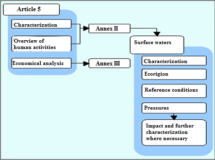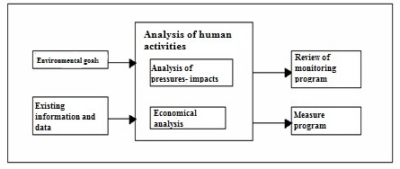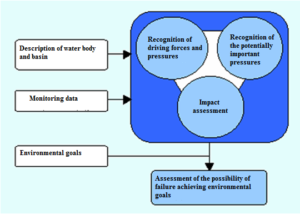Pressure and impact (IMPRESS) analysis plays a key role in the application of the Water Framework Directive (WFD). Specifically article 5 states: “Each Member State shall ensure that for each river basin district falling within its territory, a review of the impact of human activity on the status of surface waters is undertaken”. The overview of human activities incorporates five distinct parts, corresponding to the sub-paragraphs of Annex II.
Steps to be followed for the IMPRESS analysis (modified by CIS working group 2.1: IMPRESS, 2003), according to Directive 2000/60 / EC.
The “characterization” refers to the description of the general characteristics and the separation of discrete water bodies, belonging to the studied catchment area, which are considered necessary for the IMPRESS analysis, as the basic functional unitis the water body. Both typology and reference conditions, although considered as essential to achieve the environmental objectives, are not necessary for the IMPRESS analysis.
The ultimate goal of the IMPRESS analysis, using data from monitoring programs, statistics, inventories, etc., is to determine where and to what extent, human activities threaten the achievement of environmental objectives of the Directive. This analysis is the first requirement of the Directive for all its members, and the following procedures are based on it:
a) the creation of a monitoring program that provides information and monitors the effectiveness of a program,
b) the Management Plan for a River
The picture below shows that this analysis is only a part of the planning process, as there is data supplying it and data depending on its results and on the economic analysis of water use, which is directly relevant to it (CIS working group 2 , 1 SEN 2003).
Details of the planning process.
The basic steps of an analysis are:
- identification of driving forces and pressures
- recognition of potentially significant pressures
- impact assessment
As significant pressures, are characterized those that result in an effect that compromises the achievement of environmental objectives (CIS working group 2,1: IMPRESS, 2003). To complete these steps, the following auxiliaries are required:
- description of a water body of a sub-basin of a river basin
- monitoring data (biological, hydromorphological, physico-chemical)
- environmental objectives
Key steps in the IMPRESS analysis (modified by CIS working group 2,1: IMPRESS, 2003).
EEA (European Environmental Agency) (2003) Europe’s water: an indicator- based assessment, Copenhagen; 99 pp.
Impress (2002), Guidelines for the analysis of pressures and impacts in accordance with the WFD. CIS Working Group 2.1, Office for Official Publications of the E. C.


